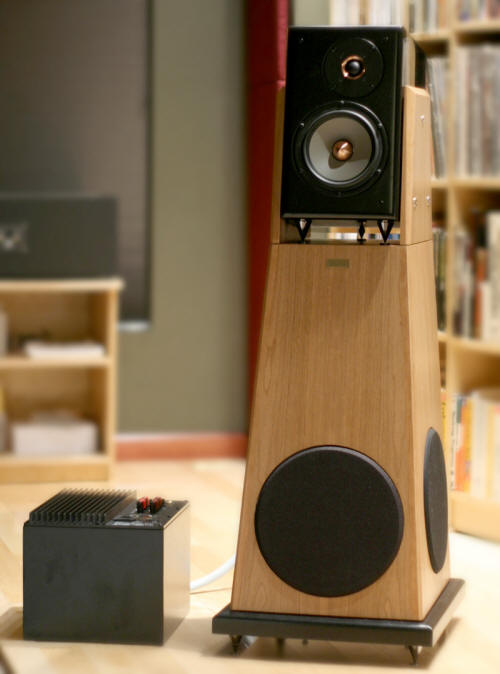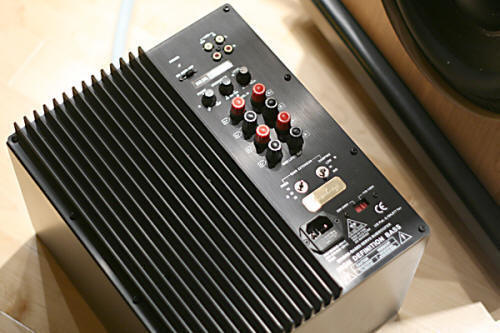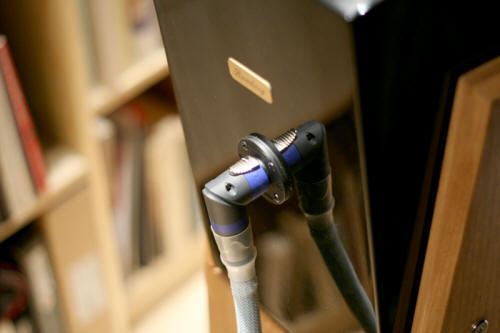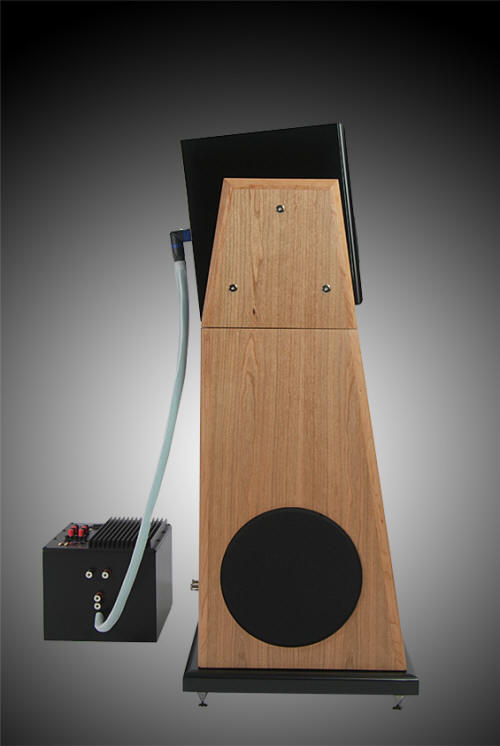
You are reading the older HTML site
Positive Feedback ISSUE
42march/april 2009
bamberg
Series 5 TMW loudspeakers
as reviewed by Adam Goldfine

|
ADAM GOLDFINE'S SYSTEM
LOUDSPEAKERS
ELECTRONICS
SOURCES ANALOG: Music Hall MMF-7 turntable, Pro-ject 9 tonearm, Pro-Ject Speed Box Mk. II, Benz Micro ACE H cartridge, Magnum Dynalab FT-101A Tuner.
CABLES
ACCESSORIES
|
As I discovered at the 2008 Rocky Mountain Audio Fest, one of the high end audio industry's best kept secrets is Bamberg Engineering Sound Lab and its founder Philip Bamberg. A mechanical and electrical engineer by education, Phil has been designing speakers under the Bamberg name as well as for commercial clients since the company's inception in 1993.
The sound of their Series 5 TMW loudspeakers was stunning at the Denver show, and way better than the $8275/pair would indicate. Of course speakers in that price range should sound very good and most do, but the Bambergs seemed to stand out compared to most of the similarly priced competition. In addition to being fast and articulate the bass was extended and well controlled in a way that is usually only heard from far more expensive speakers. I immediately requested a pair for review and in mid December my sample arrived.
The TMW in the model designation I assume stands for Tweeter, Midrange and Woofer and is indicative of its three way design. The speakers are a two cabinet bi-amped affair comprised of a powered subwoofer and a compact monitor that sits atop the sub cabinet. Featuring a sealed alignment, the monitor is also available without the subs as a stand mounted unit, the Series 5 MT ($2475/pair). The monitors' driver complement includes a 7" SEAS W18EX-001 magnesium cone midrange/bass driver and a liquid cooled 25mm SEAS Millennium soft dome tweeter both mounted on a 1" thick MDF baffle. The sensitivity is a bit on the low side at 83dB, though I never found this to be a problem.
The tweeter is offset to the inboard side of the speaker's centerline forming a mirror image pair. The beautiful piano black finish is a nice contrast to the subwoofers' wood veneered cabinets. Wooden side panels, veneered and grain matched to the subs, attach to either side of the monitors giving the fully assembled speaker an attractive, one piece, if somewhat unusual look in the Danish Modern tradition.
The bass units contain an active driver; a front mounted Peerless XLS 10" unit and dual opposing passive drones mounted on either side of the cabinet. The front baffle and cabinet sides are formed from 1.5" thick MDF and come finished in a choice of matte finish Cherry or Maple veneer.
The speakers, which are only available factory direct, arrived in four wooden crates and a cardboard box containing many parts and an Allen wrench. Though my pair contained no instructions (yours will), a brief explanation from Operations Manager Steve Fay made assembly fairly straightforward, if a bit more involved than most speakers where you simply attach the spikes, wire ‘em up, and go.
First a set of included cones is attached to the subwoofers. (A set of floor protectors is even provided for wooden floors; nice touch!). Two tall and one short cone then attach to the monitors tilting them back to match the angled baffle of the subs. The side panels are attached to the monitors, then, using a supplied template, the monitors are carefully placed on provided protective cups atop the subs. Though the speakers aren't particularly heavy, I recommend engaging the services of a friend to avoid damaging yourself, the speakers or your floors.
Both the subwoofer amplifier and the crossover are external and contained in a single box that tethers to the speaker. Being a bi-amped speaker, wiring the speakers was a bit more involved and more complex sounding than it actually is. First a set of single ended interconnects are run from the output of the preamp to the RCA inputs of the dedicated subwoofer amp/crossover. This input is then split with a low pass filter sending the signal to the subwoofer amp and a high pass filter sending the signal to a set of RCA output jacks.

The high pass signal is routed from the RCA output jacks to your amplifier. A pair of speaker cables is then run from the amplifier to a set of binding posts on the amp/crossover box. That signal is then fed into the monitors' external crossover and a tethered umbilical cord is connected to the monitor with a speakon connector. You may think that is a lot of wire in the path but it's really just one extra set of interconnects taking the high pass signal to your amp. Think of the umbilical cord as the lead wires from the crossover to the midrange and tweeter.

The low pass signal taken from the input jacks is routed to the sub amp and fed to a pair of binding posts which are connected to the subwoofer via another pair of speaker cables. All in all you need a long set of interconnects to go from your preamp to the bass amp/crossover and one extra set to take the high pass signal back to your amp. A pair of speaker cables is included to connect the bass amp to the subs.
Because I typically run my system balanced and didn't have any high quality single ended cables on hand, Steve Fay provided two sets of Fayz 6 interconnects which I used for all of my auditioning. I drove the monitors with a pair of Spectron Musician III Mk. 2 monoblocks using DH Labs' Q-10 speaker cables. (My own Vacuum State Electronics cables and most other pre-terminated speaker cables don't fit the Spectrons due to the wide spacing of the binding posts on the Spectrons in mono mode.) Towards the end of the audition I received a pair of Spectron's dedicated Remote Sense speaker cables made by JPS Labs using their next to top of the line Superconductor 3 wire.
After some experimentation I ended up placing the speakers where my Wilson Benesch A.C.T. speakers worked best, a little over 9 feet from the back wall and about 2 ½ feet from the side walls. The Bambergs seemed to benefit from a bit more toe in than the WBs with the tweeter axis crossing just behind my head. I did all of my listening with the grills off.
Typical of most subwoofer amps there were controls for level, phase, and high pass settings with the factory defaults marked. I used the recommended settings for the high pass and phase controls and set the bass volume a touch lower than the default. Though there is no modal ringing in my room, like most small rooms it has a bit of gain in the bass. It was nice to be able to dial it back a bit.
In addition there is also a bass extension control with two toggle switches. One sets the extension to 14, 20, or 28Hz and the other has three damping settings, Low, Mid, or Hi which alter the amp's output impedance. (Hi is the lowest output impedance or the highest damping factor.) I did end up setting the damping switch to Mid as Low (the default) was a bit loose and Hi a bit over damped in my room. The differences were fairly subtle making it easy to find a just right setting. The box also contains a three position tweeter contour switch for distant, neutral, and airy settings. I found neutral (also the default) to work best.
As I had been quite impressed with their sound at RMAF, I had high expectations for the speakers and I wasn't disappointed. They were very promising, if a bit veiled sounding, fresh out of the box so I let them run in for about 200 hours before doing any serious listening.
After break in the speakers had the kind of dynamic range and freedom from strain you usually only find with much more expensive speakers. I also found them to be tonally neutral and very similar in that regard to my Wilson Benesch A.C.T. speakers. The bass was very fast and tight, with no overhang. It was transparent, extended, and punchy; neither over damped nor wooly. In fact the bass was very nearly world class and I can't think of another speaker even close to twice the price with the quality and depth of bass produced by the Bambergs. These things play with authority!

Soundstage width and focus were very good, if not producing the kind of "ghostly apparition materializing in thin air" experience I've heard from more exotic speakers such as the YG Acoustic Anat Reference II Studios, $70K/pair, (currently in residence chez moi), the new Wilson Audio MAXX Series IIIs, $68K/pair, or to a lesser degree my own WB speakers, $17,250/pair. That the speakers didn't quite disappear in the way the aforementioned speakers do is, I'm guessing due to some veiling of very low level ambience details and blurring of the image that are an artifact of the MDF material used in constructing the cabinets.
Having lived with a carbon fiber cabinet speaker for nearly two years now, it's impossible not to hear a slightly softened character from nearly every dynamic speaker I've heard made of MDF, and the Bambergs are no exception. I'm not saying they sounded thick or veiled at all. In fact I was in no hurry to swap them out for my own speakers and listened very happily for extended periods of time. But in comparison with some of the best, far more expensive speakers there was more speaker there; less of a sense of freedom from the box. Their sense of front to back layering however was exceptional.
The speakers also lacked the top to bottom coherency and cut from the same cloth quality across the frequency range of the twice the price WBs. Unusually, the bass outperformed the mid bass on up. And while they excelled in their rendering of macro dynamics they lacked the micro dynamic finesse of the best.
But to be clear, their performance was exceptional and among the best I've heard at the price especially taking into account their bass extension and quality. Keep in mind, I'm drawing comparisons to speakers that cost upwards of $17,000 and at that price, those speakers should be better, and they are.
Also, swapping the DH Labs cable for the $2649/pr Remote Sense cables improved both the resolution of low level detail and the speakers' sense of coherency. They didn't completely eliminate the character I heard however, which was absent using the same DH Labs cables with my Wilson Benesch or the YG Acoustics speakers.
So much for the slicing and dicing. The litmus test of any piece of gear for me is does it make music. And these babies did. Harry Connick Jr.'s "Don't Get Around Much Anymore", When Harry Met Sally, (CD, Columbia CK 45319) had remarkable presence and a sense of effortlessness. I found it easy to relax and forget the gear and just listen to music.
Bach's Toccata & Fugue, Telarc Sampler 1, (CD, Telarc CD-80101) was reproduced with appropriate scale and dynamics with no sense of compression, rare in this price category. They resolved the spatial relationship of the pipes even if they didn't quite recreate the acoustic space as transparently as I've heard. I found the speakers to be wonderful for large scale, dramatic orchestral music. I kept marveling at the fact that I was getting this level of performance at this price point.
My all time bass torture test is "Cousin John" from Marcus Miller's M2, (CD, Telarc CD-83534) and the Bambergs passed with flying colors, sorting out the dense, bass heavy mix with grace and ease. Most speakers anywhere near this price range just fall apart on this track, the Jaton A&V 803s being a notable exception. The intertwining bass rhythms were fast, articulate, musical, and authoritative.
Phil Woods' "Charles Christopher", Chesky Records Jazz Sampler & Audiophile Test CD, (CD, Chesky JD37) had remarkable presence and poise. Woods' alto sax had the right balance of reed and metal and the speakers were never flustered by the wide dynamic range of this recording.
The male chorus on Randall Thompson's Testament of Freedom, HDCD Sampler, (CD, Reference Recordings RR-S3CD) was portrayed with an exceptional sense of front to back layering. The insistent beating of the bass drum was tight with excellent weight. The timbre of the horns was well resolved, rich in tonal colors. I didn't hear the level of back of the stage resolution and ambience retrieval I'm used to, but these are minor quibbles.
All speakers are a series of compromises and the Bambergs are no exception. The task of any designer is to balance the compromises in such a way as to have the least impact on the listener's musical enjoyment. The Bambergs never failed to deliver in that regard and while they didn't have quite the resolution of low level detail or micro dynamics of some costlier speakers, I never felt a need for more. I was in no rush to return my reference speakers to the system and that is always a good sign.
In addition, the speakers have excellent macro dynamic range, exceptionally clean and extended bass, and neutral tonal balance. If you didn't know there was better at a higher price, these wouldn't send you looking. For many people these could easily be the last speakers they ever buy and they are an easy recommendation. At the introductory price, they are a steal. Adam Goldfine
5TMW loudspeakers
Retail:
$8275/pair (introductory price $5980)
Bamberg Engineering Sound Lab
Sandwich, IL 60548
TEL: 815.786.7429
web address:
www.bambergaudio.com
email address:
[email protected]
Manufacturer's Comments
We were pleased that Positive Feedback approached us during the 2008 Rocky Mountain Audio Fest with a request to review the Bamberg Series 5 speaker system.
You commented that the sensitivity was on the low side. Allow me to explain. First, some manufacturers quote half-space sensitivity instead of full-space. This adds 6dB to the spec, but they rarely indicate the reference space. Next, a rule of thumb is to take the woofer manufacturer's catalog spec (89dB) and then subtract ~6dB to account for the baffle step correction (if properly applied). So a single 89dB woofer leads to 83dB full-space sensitivity in the system crossover. (If you come across a speaker whose sensitivity exceeds this calculated number, listen for it sounding too thin or forward. That is a clue that the baffle rise was not sufficiently compensated for by the crossover designer.) Finally, bear in mind that parallel-wired dual woofer monitors are 6dB more sensitive than single woofer models. Therefore, you will find many 4ohm, dual-7" woofer monitors whose sensitivity is right around 89dB.
We have found that this single-woofer system creates a three dimensional image a little better than our earlier dual-woofer designs. Tilting back the monitor 6 degrees leads to this benefit. In the development process we were pleasantly surprised to discover how well it portrayed image depth and height. This was especially apparent at RMAF.
You also described the unique wiring in an easy to understand way. We couldn't have explained it better. This is always a sticky subject when it comes to the sale of our product, because the true high-end customer gets nervous about retaining his main amplifier and favorite speaker cables. As you discovered, the main impact of our setup is the requirement of two pairs of sufficiently long interconnects. Normally we recommend that the main amp is located somewhere between and behind the speakers to keep the cable runs among the three amps of reasonable length. Then all that is needed is one long pair from the preamp, should the equipment be located off to one side. Ultimately, the customer keeps his favorite amplifier and cables. We supply the subwoofer amps and extra cables.
The primary reason for routing the signal through the power modules is simply because the active high-pass filter is located there. In a regular 3-way speaker with passive crossover, there are several large passive crossover components needed to divide the signal between subwoofer and monitor. But this is a very inefficient method, and can also cause veiling to the monitor, plus a softening to the bass. We have known for a very long time that a better way is to exchange these parts with an equivalent high-pass filter before the main amplifier. This always leads to more resolution, greater linearity, lower distortion, and improved dynamics. Obviously Adam discovered proof of this by the outstanding bass performance and extra clarity from the monitor.
Thank you for the kind words about the Bamberg Series 5 speaker system. Your time with it confirms what the secret in the best kept secret truly is—that our speakers perform well beyond their price.
Philip E. Bamberg
Bamberg Audio

